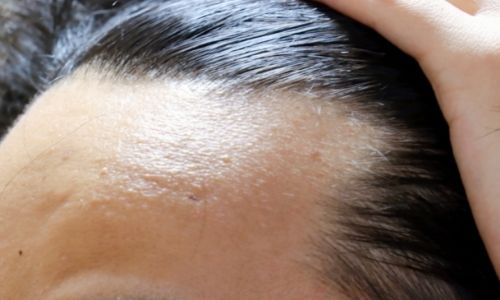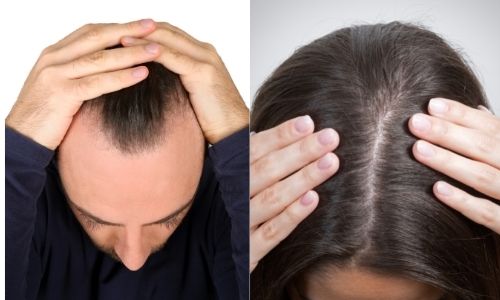Do you know what your hairline is? Or, do you know why you have such a hairline? If not, read this article to know what your hairline is called.
The hairline is the forehead area or the edge at the frontal region where your hair grows on the head.
Commonly you must be calling it the shape of your hair. Everyone has a different hairline as it has types and it grows based on a few factors that we will learn next. If you are not happy with your hairline, you can even change it after consulting your doctor.
To learn about the different hairline types of women and men and which one is the best and easy to maintain, read on!
Why do you have this type of hairline?

The type of your hairline is based on your lifestyle habits. If not habits, your hairline might be affected by hormones or age. Through your age, the hairline may change.
The problems with your hairline are not necessarily genetic as, if you have an even hairline at a young age, it may turn into an uneven one maybe because of lack of care of hair. Also, medical conditions or medicinal side effects can bring change to your hairline.
In women, the change can be because of the constant pull of hair when they tie a pony, bun or clip the hair. They lose their hair as well as their ‘even hairline.’ Stress is also a significant hair loss reason, and therefore now you know that stress can worsen your hairline too.
Types of hairline in men and women

According to the external and internal factors mentioned above, the hairline differs from person to person. And women and men have common hairlines, but it may seem different because of various haircuts.
Usually, women tend to have long hair and men short hair. It may seem different from the outside, but the hairline is similar under their bush of hair. Let us now dive deeper into the types of hairlines to let you know your type.
1. Low Hairline
The hairlines close to your eyebrows are known as low-type hairlines. It seems like the forehead is short for people who have this type. Initially, it may seem awkward to have a narrow forehead, but it is an advantage in old age.
How? Your hair starts receding through age, and those who have a low hairline, hairs grow higher, that is, away from eyebrows as they get older.
It is said that people with this type of hairline have dense hair growth. Therefore, they need not be concerned about problems like baldness.
2. High Hairline
The growth of hair from above the crown line is the result of high-type hairlines. And vice-versa of low-type, it makes the forehead seem broader.
Also, it does not benefit in old age as people with high-type hairline have the chance of losing hair or facing baldness faster.
Having such a hairline is commonly genetic or hair loss at a young age. But, it doesn’t mean that a person with a high hairline has thin hair. No, they can have thick hair but start high to the temples.
3. Middle Hairline
Middle or medium hairline is the average or normal hairline, not too closer to the eyebrows or higher above the crown line. It is easy to make any hairstyle for women having the average distanced hairline.
Commonly teenagers have middle hairlines, also known as the normal hairline. People say it looks appealing on every shape of faces. Therefore, it is the most prefered hairline type.
4. Straight Hairline
A straight hairline is a straight line with a 90-degree angle on both ends. It looks like a rectangular forehead. Some people, especially men, go to the salon to get a straight hairline. Otherwise, it is genetic in both men and women.
Mostly women with straight hairlines tend to face less hair fall. And it is easily manageable for both men and women.
5. Widow’s Peak Hairline
Widow’s Peak hairline has a V-shape, higher from the sides and pointed or lowered at the middle. The growth of hair is more at the centre. It can be genetic or because of a genetic disorder.
Most men face widow’s peak hairline at old age due to hair loss, and in women, it can be more prominent or less at old age.
6. Rounded Hairline
A rounded or bell-shaped hairline grows hair in a round shape across the forehead. There are no sharp edges, angles, or uneven lines in this type of hairline.
The forehead may appear long, and people with dense hair commonly have a round or oval-shaped hairline. In this type, there is less chance for people to lose the volume of their hair.
7. Uneven Hairline
The asymmetrically-shaped hairline is known as an uneven hairline. Both sides of the forehead have different shapes. This type is common in many people. The cause can be damaged hair follicles, genetic or baldness in men.
If there is slight unevenness, then it is not an issue of concern, but with high zig-zag symmetry, you can have dips, rises, or jagged edges unevenly anywhere on hairlines.
Tip: Avoid pulling your hair tight to tie up as it may result in an uneven hairline.
8. Cowlick Hairline
A cowlick is commonly genetically grown on the crown head in different angles than other hair on the head. Also, it can be present at the hairline of the forehead.
The hair grown against the natural direction of hair growth may give a messy look. And many people find this type of hairline challenging to set.
9. Receding Hairline
You know the meaning of receding. Right? It is going back from its position. So, now the meaning of receding hairline is understandable. The hairlines move back mostly because of ageing. It is more common in men than women.
The reasons for receding hairline can be your family history or hormone changes. In females, wrong hairstyles may also result in moving higher of a natural hairline and making the forehead look larger.
It is also known as male pattern baldness, where male loses hair at both the corners of the hairline. And female pattern baldness is hair loss or hair thinning and when new hair stops growing at the frontal zone of the hairline.
10. M-shaped Hairline
M-shaped hairline is a broader widow’s peak hairline. It doesn’t form a V shape but an M shape. Many males and females have this type of hairline naturally. But if their hair turns into an M-shaped hairline later, it is because of hair loss from the sides of the frontal-zone hairline.
11. Triangular Hairline
A triangular hairline has the opposite look of a widow’s peak hairline. And it has a similar height and shape, like a round-shaped hairline. The triangle point doesn’t need to face at the centre only. It can also be at any of the corners of the forehead hairline.
What is the perfect hairline?

The answer to this question depends on you. The most preferred type of hairline is the medium or middle hairline. But, people also like a low hairline as it is most advantageous at an older age. And the straight hairline is also liked by many people as it is easy to maintain and style.
Rounded hair is also good as people with round-shaped hairlines have dense hair and less chance to lose through age. None of the types is perfect. It is upon your choice and how you take care of your hair and improve lifestyle habits.
You May Also Like To Read:
Common Hair Problems | Their Causes And Solutions
How To Wash Your Hair With Shampoo?
Conclusion
The hairline is the edge of hair growth on the forehead. And it can be of different types. Each person has a different hairline because of genetics, hormone changes, lifestyle habits, or ageing.
Maybe the reason behind the type of hairline could be the side-effects of any medicine or genetic disorders.
The common types of hairline people have are low, high, middle/medium, straight, uneven, cowlick, rounded, u-shaped, widow’s peak, triangular, m-shaped, and receding hairlines.
They all differ in shape and height, and the main reason for changing hairline shape at a young age could be hair loss.
We hope you found this article helpful, and now you got a name for your hairline. Do share your experience of reading the article about ‘different types of hairlines’ with us in the comment section below.


